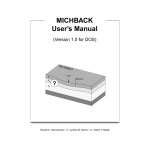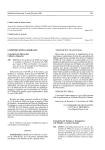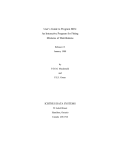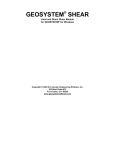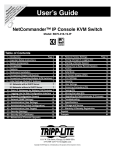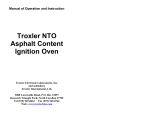Download MICHPAVE User`s Manual - Michigan State University
Transcript
MICHPAVE User’s Manual (Version 1.2 for DOS) Asphalt Base Roadbed Ronald S. Harichandran Gilbert Y. Baladi MICHPAVE USER’S MANUAL (Version 1.2 for DOS) by Ronald S. Harichandran Associate Professor and Gilbert Y. Baladi Professor Department of Civil and Environmental Engineering Michigan State University East Lansing, MI 48824-1226 January 2000 1995 Michigan State University Board of Trustees ii Table of Contents 1. 2. 3. 4. 5. 6. 6. Introduction.................................................................................................................1 Summary of Modeling and Analysis ..........................................................................1 2.1 Modeling of the Pavement ........................................................................1 2.2 Granular and Cohesive Material Models ..................................................1 2.3 Gravity and Lateral Stresses .....................................................................1 2.4 Finite Element Analysis............................................................................2 2.5 Computation of Stresses and Strains at Layer Interfaces..........................4 2.6 Estimated Equivalent Resilient Moduli ....................................................4 2.7 Fatigue and Rut Depth Prediction.............................................................4 System Requirements..................................................................................................4 Configuring the Computer ..........................................................................................5 4.1 Installation Procedure ...............................................................................5 4.2 The CONFIG.SYS File.............................................................................5 4.3 Required Amount of Free Memory...........................................................5 4.4 Printing Graphics ......................................................................................5 4.5 Running MICHPAVE for the First Time..................................................6 Using MICHPAVE .....................................................................................................6 5.1 Filenames ..................................................................................................6 5.2 Cursor Movement and Editing Keys.........................................................6 5.3 Title Screen ...............................................................................................7 5.4 Main Menu................................................................................................7 5.5 Data File Menus and Associated Data-Entry Forms.................................9 5.6 Performing Analysis ...............................................................................16 5.7 Plotting the Results .................................................................................18 5.8 Printing the Results .................................................................................20 Problem Reporting ....................................................................................................20 References.................................................................................................................20 iii List of Figures Figure 1. Figure 2. Figure 3. Figure 4. Figure 5. Figure 6. Figure 7. Figure 8. Figure 9. Figure 10. Figure 11. Figure 12. Figure 13. Figure 14. Figure 15. Figure 16. Figure 17. Figure 18. Figure 19. Figure 20. Figure 21. Figure 22. Figure 23. Figure 24. Resilient modulus model for granular soils ................................................................2 Resilient modulus model for cohesive soils................................................................2 Typical finite element mesh........................................................................................3 Title screen..................................................................................................................8 Credits screen..............................................................................................................8 Main menu ..................................................................................................................9 Overview flowchart of the MICHPAVE program......................................................9 New data file menu ...................................................................................................10 Data-entry form for initial data .................................................................................10 Data-entry form for fatigue life and rut depth ..........................................................11 Data-entry form for layer type ..................................................................................12 Data-entry form for linear elastic (type 1) material properties ................................12 Data-entry form for granular (type 2) material properties ........................................13 Data-entry form for cohesive (type 3) material properties ......................................13 Data-entry form for specifying the number of cross sections along which results are computed .................................................................................................14 Data-entry form for specifying the location of horizontal cross sections.................14 Data-entry form for specifying the location of vertical cross sections .....................15 Data-entry form for modifying the number of elements in the vertical direction ....................................................................................................................16 Data-entry form for modifying the number of elements in the horizontal direction ...................................................................................................16 Typical display during computation .........................................................................17 Typical design summary ...........................................................................................17 Plot menu for selecting sections ...............................................................................18 Menu for plots along vertical cross sections.............................................................19 Menu for plots along horizontal cross sections........................................................19 List of Tables Table 1. Keypad functions within data-entry forms .................................................................7 iv 1. Introduction MICHPAVE is a user-friendly, non-linear finite element program for the analysis of flexible pavements. The program computes displacements, stresses and strains within the pavement due to a single circular wheel load. Useful design information such as fatigue life and rut depth are also estimated through empirical equations. Most of MICHPAVE is written in FORTRAN 77. Graphics and screen manipulations are performed using the FORTRAN callable GRAFMATIC graphics library, marketed by Microcompatibles Inc., 301 Prelude Drive, Silver Spring, MD 20901. 2. Summary of Modeling and Analysis This section gives a summary of the modeling and analysis so that the user is aware of the capabilities and limitations of the MICHPAVE program. Further details about the modeling and analysis, and various sensitivity studies, are given in the works by Yeh (1989), and Harichandran, et. al. (1989, 1990). 2.1 Modeling of the Pavement Each layer in a pavement cross section is assumed to extend infinitely in the horizontal directions, and the last layer is assumed to be infinitely deep. All the pavement layers are assumed to be fully bonded so that no slip occurs due to applied load. Displacements, stresses and strains due to a single circular wheel load are computed. Due to the assumptions used, the problem is reduced to an axisymmetric one. 2.2 Granular and Cohesive Material Models The so-called K-θ model is used to characterize the resilient moduli of granular (type 2) materials. This model is of the form M R = K 1θK 2 in which θ = σ1 + σ2 + σ3 = bulk stress and MR = resilient modulus, and K1 and K2 are material properties. For this model, log MR varies linearly with log θ as shown in Fig. 1. The resilient modulus for cohesive soils is specified in terms of the deviatoric stress through the bilinear model: K 2 + K 3 [ K 1 – ( σ 1 – σ 3 ) ], MR = K 2 + K 4 [ ( σ 1 – σ 3 ) – K 1 ], when ( σ 1 – σ 3 ) ≤ K 1 when ( σ 1 – σ 3 ) > K 1 This model is illustrated in Fig. 2. 2.3 Gravity and Lateral Stresses The MICHPAVE program includes the effect of gravity and lateral stresses arising from the weight of the materials. At any location within the pavements, the vertical gravity stress (σg) is computed as the accumulation of the layer thicknesses multiplied by the appropriate unit weights. The lateral stress is taken as 1 log MR K2 1 log K1 log θ Figure 1 Resilient modulus model for granular soils σh = K0σg where K0 = coefficient of earth pressure at rest. For granular soils K0 = 1 − sin φ and for cohesive soils K0 = 1 − 0.95 sin φ, where φ = angle of internal friction. To approximately account for “locked-in” stresses caused by compaction, the user can input a value for K0 higher than the coefficient of earth pressure at rest. 2.4 Finite Element Analysis Rectangular four-noded axisymmetric finite elements with linear interpolation functions are used in all upper layers and through the depth specified by the user for the last layer (the roadbed). A lateral boundary is placed at a radial distance of 10a from the center of the loaded area, where a = radius of the loaded area. A default mesh is initially generated, but this may be modified by the user. The default mesh has the following characteristics: MR K3 1 K4 K2 1 σ1 − σ3 K1 Figure 2 Resilient modulus model for cohesive soils 2 • In the radial direction, the total width of 10 radii is divided into four regions. Within any region, all elements have the same horizontal dimension. The first region, between 0 and 1 radius, is equally divided into four elements; the second region, between 1 radius and 3 radii, is equally divided into four elements; the third region, between 3 radii and 6 radii, is equally divided into three elements; and the fourth region, between 6 radii and 10 radii, is equally divided into two elements. • Within any layer, all elements have the same vertical dimension. The number of elements in each layer in the vertical direction is dependent on the layer thickness, but at least four elements are used in the top (AC) layer, and at least two elements are used in all other layers. A typical default finite element mesh is shown in Fig. 3. Displacements, stresses and strains are computed only within the region modeled by finite elements. In order to increase accuracy, and to reduce the memory and computation time required by the program, the infinite extent of the last layer is modeled by using a flexible bottom boundary (Harichandran and Yeh 1989). The half-space below the bottom boundary is assumed to be homogeneous and linear elastic. The modulus of the half-space is taken as the average moduli of the finite elements immediately above the bottom boundary. The non-linear analysis consists of several iterations. A linear analysis is performed in each iteration, after which the resilient modulus of each finite element is revised if necessary. If the Mohr-Coulomb failure criterion is violated in any granular or cohesive soil element, then the principal stresses are modified to reflect the failure condition, and the resilient moduli are determined from the modified stresses (Raad and Figueroa 1980). The iteration is repeated until the resilient moduli of all the elements stabilize. Depth 0.0" Asphalt 10.0" Base 30.0" Roadbed 0 a 3a 6a 50.0" 10 a Radial Distance in Radii (Radius of loaded area, a = 5.35 in.) Figure 3 Typical finite element mesh 3 2.5 Computation of Stresses and Strains at Layer Interfaces For the interpolation functions used in the finite element approach, stresses and strains are most accurate at the center of elements. The following techniques are used to obtain improved estimates of some stresses and strains at layer interfaces: • The vertical stress is obtained from the vertical stresses at the center of the two elements above and the two elements below the interface by using cubic interpolation. • The radial, tangential and shear stresses and vertical strain are obtained using extrapolation of the corresponding quantity at the center of the elements on one side of the interface. If at least four elements are available then cubic extrapolation is used, if three elements are available then quadratic extrapolation is used, and if only two elements are available then linear extrapolation is used. 2.6 Estimated Equivalent Resilient Moduli At the end of the analysis, MICHPAVE outputs an equivalent resilient modulus for each pavement layer. These equivalent moduli may be useful if further analyses is to be performed using other programs that assume linear elastic materials. The equivalent moduli for each layer is computed as the average of the moduli of the finite elements in that layer that lie within an assumed 2:1 load distribution zone (Harichandran et. al. 1990). 2.7 Fatigue and Rut Depth Prediction Results from the non-linear mechanistic analysis, together with other parameters, are used as input to two performance models derived on the basis of field data (Baladi 1989), to predict the fatigue life and rut depth. These performance models are currently restricted to three-layer pavements with asphalt concrete (AC) surface, base and roadbed soil, and four-layer pavements with AC surface, base, subbase and roadbed soil. Fatigue life and rut depth estimates for other types of sections may be meaningless. The models relate the fatigue life and rut depth to the number of equivalent 18-kip single-axle loads, surface deflection, moduli and thicknesses of the layers, percent air voids in the asphalt, tensile strain at the bottom of the asphalt layer, average compressive strain in the asphalt layer, kinematic viscosity of the asphalt binder, and average annual air temperature. 3. System Requirements The MICHPAVE program was originally written for IBM compatible personal computers running under DOS. Presently it is also available for Sun and Hewlett-Packard workstations running under UNIX. For DOS systems, the following hardware and software are required: • PC-DOS or MS-DOS version 3.0 or higher • 640 KB of random access memory (RAM) • A hard disk • A color graphics adapter (CGA, EGA or VGA) and compatible monitor Although not strictly required for the use of the program, the following hardware is strongly recommended: 4 • A math co-processor (8087, 80287 or 80387). Running time will be greatly increased if a math co-processor is not installed. • A printer for obtaining hardcopies of plots and output. 4. Configuring the Computer 4.1 Installation Procedure The MICHPAVE program is initially supplied a diskettes. To install the program on a hard disk, first make a subdirectory to hold the program (e.g., MD \MPAVE), change to this directory (e.g. CD \MPAVE), insert the diskette in drive A:, and type COPY A:*.*. 4.2 The CONFIG.SYS File In the root directory, there is a file named CONFIG.SYS which configures the PC system and loads any requested device drivers when the computer is turned on. The following statement will need to be added to the CONFIG.SYS file, if it does not already exist: FILES=20 The MICHPAVE program uses a FORTRAN callable graphics package called GRAFMATIC. Unfortunately, this package is not compatible with the ANSI.SYS device driver used by some other programs for screen manipulations. Thus, if the CONFIG.SYS file has the statement DEVICE=ANSI.SYS then this statement will need to be removed and the computer re-booted (by simultaneously pressing the CTRL, ALT and DEL keys) before running MICHPAVE. If available, use of an ANSI.SYS compatible device driver that can be unloaded from memory on demand is convenient since it eliminates the need to re-boot the computer. 4.3 Required Amount of Free Memory The MICHPAVE program requires about 515 KB of free memory to run. DOS and memory resident programs (such as SIDEKICK) reduce the amount of free memory for use by other programs. The amount of free memory available can be checked by using the DOS command CHKDSK. If there is insufficient free memory, then memory resident programs will need to be removed before running MICHPAVE. If there is insufficient memory to load the program, the following message will be displayed: Program too big to fit in memory. Sometimes the program may load into memory without any problem, but the following error message may be displayed during computations: Run-time error F6700: -heap space limit exceeded. This also indicates that there is insufficient free memory. 4.4 Printing Graphics Graphic screens produced by MICHPAVE can be dumped onto an attached printer if the DOS command GRAPHICS.COM is issued after the computer is turned on and before MICHPAVE is used. It may be convenient to include the command in the AUTOEXEC.BAT file so that 5 it is issued every time the computer is turned on. To download graphics that are on the screen to the printer simply press the SHIFT and PrScr keys simultaneously. 4.5 Running MICHPAVE for the First Time To run MICHPAVE simply type: MICHPAVE. When running for the first time, the program will request the following information about the computer system: Which graphics adapter and monitor do you have (MONO/CGA/EGA)? Is your computer strictly IBM compatible (Y/N)? Is your printer EPSON or EPSON compatible (Y/N)? The response to the above prompts are stored in a file named SYSTEM.DAT. When running MICHPAVE subsequently, the system information is read from this file. In case a mistake is made when specifying this information, or if the graphics adapter in the computer or the printer is changed at a later time, the file SYSTEM.DAT should be deleted before running MICHPAVE so that it will prompt again for a description of the new hardware. The graphics resolution for EGA systems will be substantially higher than for CGA systems. For VGA systems, specify EGA. If the computer is not strictly IBM compatible, then problems may be encountered with the data-entry forms due to incompatibility with the graphics software, if the computer had originally been specified as being fully IBM compatible. By defining the computer to be not strictly IBM compatible MICHPAVE can still be used, but some of the color used to enhance the data-entry forms will be lost. For EPSON compatible printers MICHPAVE automatically sets the print mode to condensed when printing the output after an analysis, so that the 132-column wide output file is printed properly. If the printer is not EPSON compatible, then its print mode will need to be set externally before printing the output. For an EPSON printer with a wide carriage capable of printing 132 characters per line in normal mode, specify the printer to be non-EPSON compatible. 5. Using MICHPAVE MICHPAVE is designed to be user-friendly. Menus are used to perform the required steps in pavement analysis, and data-entry forms facilitate data input. In addition, extensive checking of input data is performed and appropriate error messages are displayed upon completion of each dataentry form. 5.1 Filenames The names of files in which the data and results are saved may include a pathname if necessary (e.g., A:I-96.DAT to save the file I-96.DAT on the diskette in drive A:, \JOB1\I-96.DAT to save the file in subdirectory JOB1, etc.). If no path is specified, the file will be saved in the default subdirectory. 5.2 Cursor Movement and Editing Keys The data-entry forms have several fields into which data is typed. The field in which the cursor resides is highlighted on IBM compatible systems. The functions of the cursor movement and editing keys within a data-entry form are described in Table 1. 6 TABLE 1 KEYPAD FUNCTIONS WITHIN DATA-ENTRY FORMS Function KEY Return/Enter Tab Shift Tab Move cursor to next field Move cursor to next field on the right Move cursor to previous field on the left Home Move cursor to first field in the form End Move cursor to last field in the form ↑ or PgUp Move cursor to field above current one ↓ or PgDn Move cursor to field below current one Backspace Delete character before cursor Del Delete character at cursor Ins Insert space at cursor → Move cursor one space to the right ← Move cursor one space to the left F1 Check validity of entries in each field and save data. If some of the data is invalid prompts will be issued for corrections. Esc Discards any changes made on the current screen and return to previous screen. 5.3 Title Screen When MICHPAVE is loaded the title screen shown in Fig. 4 is displayed. Pressing the F1 key displays the credits screen shown in Fig. 5, while pressing any other key displays the main menu. 5.4 Main Menu The main menu is shown in Fig. 6. Any one of the nine options shown on the menu may be selected by typing a number from 1 to 9. These options are described below: • Option 1: Displays the overview flowchart of the MICHPAVE program shown in Fig. 7. • Option 2: Used to input data relating to a new pavement analysis problem. • Option 3: Used to change data for the problem currently being worked on. • Option 4: Used to read the data from a previously defined problem, and modify it if necessary. The name of the file in which the previous data was saved will be requested. • Option 5: Performs non-linear finite element analysis after all the required data has been specified. MICHPAVE creates two files named V.PLT and R.PLT after an analysis. These files contain results used in subsequent plots. • Option 6: Displays a summary screen containing the results commonly used in design. This option can only be used following an analysis. • Option 7: Plots displacements, stresses and strains on the screen along requested vertical and horizontal sections. This option is normally selected after an analysis. If chosen before an analysis, the results from the previous analysis are plotted if the files V.PLT and R.PLT have not been erased. 7 Version 1.2 MICHPAVE Nonlinear Finite Element Program for Analysis of Flexible Pavements Developed for Michigan Department of Transportation by Dept. of Civil & Environmental Engineering Michigan State University East Lansing, MI 48824-1226 For further information, call: (517) 355-5107 F1 to list credits Press any key to start Figure 4 Title screen MICHPAVE Version 1.2 April 1994 Conceptual Development by: Ronald S. Harichandran, Gilbert Y. Baladi, and Ming-Shan Yeh Ported to UNIX by: Ronald S. Harichandran and Baoyan Wu Development of Version 1.0 for DOS Funded by: Michigan Department of Transportation Acknowledgement: Various State Highway Agencies provided the data used to develop the rut and fatigue models Press any key to start Figure 5 Credits screen 8 MAIN MENU 1. 2. 3. 4. 5. 6. 7. 8. 9. Overview Create a New Data File Change Current Data File Modify an Existing Data File Perform Analysis Type summary results on screen Plot Results on screen Print Results on printer Exit-Return to DOS Selection: Figure 6 Main menu • Option 8: Used after analysis to print results on the printer from within the MICHPAVE program. The output requires a line width of 132 characters. EPSON compatible printers are automatically set to condensed mode by the program. • Option 9: Terminates the MICHPAVE program and returns to DOS. 5.5 Data File Menus and Associated Data-Entry Forms Data File, Modify Current Data File, and Modify Existing Data File menus are displayed when selecting options 2, 3 or 4, respectively, from the main menu. All three menus are identical in structure, and the first is shown in Fig. 8. The only difference between these menus is that in MAIN MENU SUBMENUS 1.Overview DATA FILE MENU Fatigue Data 2.Create a New Data File 1.Initial Data 3.Change Current Data File 2.Layer Type 1.Asphalt 4.Modify an Existing Data File 3.Material Properties 5.Perform Analysis 4.No. of Cross Section for Comput. of Stress & Disp. 2.Granular 3.Cohesive 6.Summary Results on Screen 5.Plot Finite Element Mesh 7.Plot Results on Screen 6.Modify Finite Element Mesh 8.Print Results on Printer 7.Return to Main Menu 9.Exit-Return to DOS Press any key to return to main menu Figure 7 Overview flowchart of the MICHPAVE program 9 Cross Section Locations DATA FILE MENU 1. Initial Data (Load, No. of Layers, Output Filename, etc.) 2. Specify Layer Type 3. Specify Material Properties 4. Specify Cross Sections for Computation of Stresses & Displacements 5. Plot Finite Element Mesh 6. Modify Finite Element Mesh 7. Return to Main Menu Selection: Figure 8 New data file menu those used for modifying data files, existing data is modified instead of specifying new data. It is recommended that the options in the data file menu be followed in sequence. When modifying an existing file it is mandatory to first use option 1 and specify new names for the required filenames, or to indicate that the input and output files used earlier should be overwritten. The other options may be performed in any sequence. 5.5.1 Option 1: Initial, fatigue life and rut depth data This option displays the data-entry form shown in Fig. 9 (typical data is also shown in bold typeface). INITIAL DATA 1. Filename to Save Data to: I-96.dat 2. Filename to Output Results to: I-96.out 3. Title: Section of I-96 at Williamston 4. Number of Layers: 3 5. Wheel Load: 6. Tire Pressure: 100.00 7. Fatigue Life & Rut Depth Computation Required (Y/N)? Y (max. 6) 9000.0 (lb.) Figure 9 (psi) Data-entry form for initial data 10 The data that should be entered into the fields are described below: 1. Filename to Save Data to: All data that is entered in this and other forms is stored in this file. The data may be recovered at a later time and modified if necessary. 2. Filename to Output Results to: The output from the analysis will be directed to this file. The output is in standard ASCII form and may be viewed or edited using any text editor. It should be noted however that a line width of 132 characters is used for the output. 3. Title: This is a description of the current job for identification purposes. 4. Number of Layers: The number of layers in the pavement section. A maximum of six layers are permitted. Note that the roadbed soil (subgrade) is counted as one layer. 5. Wheel Load: Equal to half the axle load in pounds. 6. Tire Pressure: The pressure in the truck tire in psi. 7. Fatigue Life & Rut Depth Computation Required (Y/N)? The user should respond with a Y if fatigue life and rut depth in the section are to be estimated. Empirical expressions are used to relate the fatigue life and rut depth to results from the mechanistic analysis. These relations are currently valid only for three-layer pavements with AC, base and roadbed soil layers, and for four-layer pavements with AC, base, subbase and roadbed soil layers (Baladi 1989). Fatigue life and rut depth estimates for other pavement sections may not be meaningful. The rut depth is estimated for the number of load repetitions causing fatigue failure of the pavement. Answering in the affirmative to question 7 in the Initial Data form displays the data-entry form shown in Fig. 10, which is used to enter data for the fatigue life and rut depth calculations. The data table below the form shows typical kinematic viscosities for different asphalt grades. The data that should be entered into the fatigue life and rut depth form are described below: 1. Average Annual Temperature: The average annual air temperature expected at the pavement location. FATIGUE LIFE & RUT DEPTH DATA 1. Average Annual Temperature: 2. Percent Air Voids in Asphalt Mix (1,3.5, etc.): 3. Kinematic Viscosity: Asphalt Grade 77.00 (Fahrenheit) 3.00 270.00 (centistoke) Typical Kinematic Viscosity (centistokes) AC 2.5 AC 5.0 AC 10 159 212 270 Figure 10 Data-entry form for fatigue life and rut depth 11 LAYER TYPE 1 Asphalt or Linear; 2 Granular; 3 Cohesive Layer number (from top) Type (1,2, or 3) 1 1 2 2 3 3 Figure 11 Data-entry form for layer type 2. Percent Air Voids in Asphalt Mix: The percent air voids in the asphalt mix as expected in the field. 3. Kinematic Viscosity: The kinematic viscosity of the asphalt binder. 5.5.2 Option 2: Layer type The type of material used for each layer in the pavement section is identified by typing 1, 2 or 3 for asphalt, granular or cohesive soil layers, respectively, into the form shown in Fig. 11. Asphalt is treated as a linear elastic material in the analysis. Lime asphalt or cement treated materials may be specified as type 3. To perform a linear analysis of the entire pavement section specify all layers to be of type 1. Specifying types 2 or 3 implies non-linear analysis. 5.5.3 Option 3: Material properties Three different sets of material properties are required for the three material types 1, 2 and 3. Properties for layers with asphalt or linear elastic materials, including the names of the layers, thicknesses, resilient moduli, Poisson's ratios, densities, and coefficients of lateral earth pressure (K0), are specified in the form shown in Fig. 12. For compacted layers, the “locked-in” lateral stresses can be approximately accounted for by specifying a relatively large value for K0 (e.g., larger than 0.4). ASPHALT MATERIAL PROPERTIES Layer 1 Name of Layer Asphalt Thickness (inches) Modulus (psi) 10.0 500000.0 Poisson's Density Ratio (lb/cu.ft) .35 150.0 Ko .40 Note: Typical values for Ko are .4 (undisturbed) to 3 (heavily compacted layer) Figure 12 Data-entry form for linear elastic (type 1) material properties 12 GRANULAR MATERIAL PROPERTIES Layer 2 Name of Layer Thick. (in.) Base 20.0 Ko K1 (psi) K2 .40 9000.0 µ Cohesion φ Density (psf) (degree) (pcf) .35 .40 .0 30.0 120.0 Resilient Modulus = K1 * (σ1 + σ2 + σ3)**K2 Material Type K1 Silty Sand Sand Gravel Crushed Gravel Slag 1620 4480 7210 24250 K2 Material Type K1 .62 .53 .45 .37 Sand/Aggregate 4350 Partially Crushed Gravel 5967 Limerock 14030 K2 .59 .52 .40 Warning: Values of K1 are dependent on the degree of saturation Figure 13 Data-entry form for granular (type 2) material properties Properties for granular layers, including the names of the layers, thicknesses, coefficients of lateral earth pressure (K0), K1 and K2 parameters, Poisson's ratios (µ), cohesions, friction angles (φ), and densities are specified in the form shown in Fig. 13. Typical values of the parameters K1 and K2 for a variety of granular soils are displayed in the table below the form. Properties for cohesive layers, including the names of the layers, thicknesses, coefficients of lateral earth pressure (K0), K1, K2, K3 and K4 parameters, Poisson’s ratios (µ), cohesions, friction angles (φ), and densities are specified in the form shown in Fig. 14. Typical values of the parame- COHESIVE MATERIAL PROPERTIES Layer 3 Name of Thick. Ko K1 K2 Layer (in.) (psi) (psi) Roadbed 20.0 .40 6.0 K3 3020.0 1110.0 K4 µ 178. .45 Coh. φ (psf) (deg) 800.0 .0 Dens. (pcf) 120.0 Note:- 1. Typical values for K1, K2, K3, K4: K1 = 6 psi, K2 = 3020 psi, K3 = 1110, K4 = 178 2. Resilient Modulus = K2 + K3 * [K1 - (σ1 - σ3)]; K1 > (σ1 - σ3) Resilient Modulus = K2 + K4 * [(σ1 - σ3) - k1]; K1 < (σ1 - σ3) 3. µ = Poisson's Ratio 0 < µ < .5 4. Layer 3 actually semi-infinite, but thickness controls depth to which displacements/stresses are computed. Figure 14 Data-entry form for cohesive (type 3) material properties 13 CROSS SECTION SPECIFICATION MENU Figure 15 Number of Horizontal Sections: 4 Number of Vertical Sections: 2 Data-entry form for specifying the number of cross sections along which results are computed ters K1, K2, K3 and K4 are given in the notes. These parameters have currently not been established widely for different cohesive soils. It should be noted that the thickness specified for the last layer (roadbed soil) controls the depth to which displacements, stresses, and strains are computed. A thickness of about 6" to 12" is recommended. For analysis, the last layer is actually considered to be semi-infinite. 5.5.4 Option 4: Cross sections for computation of results Displacements, stresses and strains are computed along horizontal and vertical cross sections specified by the user. The number of horizontal and vertical sections are specified in the data-entry form shown in Fig. 15. At least one vertical section must be used. The depths at which the horizontal sections are located are specified in the data-entry form shown in Fig. 16. To aid in these specifications the thickness of each layer in the pavement section is displayed in the upper table on the right. Although the horizontal sections may be specified at any depth within the pavement, in the finite element method some stresses and strains are most accurately computed at the center of elements. Thus, best results will be obtained if the locations of the horizontal sections correspond to the mid-depths of elements. Optimal locations within each layer, corresponding to the mid-depths of the elements in that layer, are shown in the lower table HORIZONTAL SECTION SPECIFICATIONS Section No. Depth (inches) 1 .00 2 10.00 3 28.00 4 33.30 Figure 16 Layer Name Thick (in.) 1. 2. 3. Asphalt Base Subgrade 10.0 20.0 20.0 Optimal Locations for stress & strain Layer Depths(in.) 1. 1.3, 3.8, 6.3, 8.8 2. 12.0, 16.0, 20.0, 24.0, 28.0 3. 33.3, 40.0, 46.7 Data-entry form for specifying the location of horizontal cross sections 14 on the right. Nevertheless, it is strongly recommended that horizontal sections be specified at each layer interface. Note that the most critical stresses are compression at the top and tension at the bottom of the AC surface, and compression at the top of the roadbed soil. The radial distances at which the vertical sections are located are specified in the data-entry form shown in Fig. 17. The first section must be located at the center of the loaded area (r = 0"). Although the other vertical sections may be specified at any radial distance within the pavement modeled by finite elements (0 to 10 radii of the loaded area), some stresses and strains are most accurately computed at the center of elements. Thus, best results will be obtained if the locations of the vertical sections correspond to the middle of an element. In MICHPAVE, the elements are grouped into three regions in the radial direction, from 0 to a, a to 3a, 3a to 6a, and 6a to 10a, where a = radius of loaded area. Optimal radial locations, corresponding to the middle of the elements, are shown in the table on the right. Due to edge effects of the right boundary, it is recommended that vertical section not be specified in the last region from 6a to 10a. The radius of the loaded area is shown in the note below the tables. 5.5.5 Option 5: Plot finite element mesh This option plots the current finite element mesh on the screen. The loaded region and the radius of the loaded area, a, are also shown. (Fig. 3 shows a typical finite element mesh for the mesh parameters given in bold typeface in Figs. 18 and 19.) 5.5.6 Option 6: Modify finite element mesh This option is used to modify the current finite element mesh. MICHPAVE automatically generates a default mesh that should be sufficient for most purposes. However, for greater accuracy, or for unusual situations, the user may wish to modify the default mesh. Memory limitations may, however, preclude the use of a very fine (large) mesh. First, the data-entry form shown in Fig. 18 is displayed for modifying the number of elements in the vertical direction, and the current number of elements within each layer are shown. All elements within a given layer have the same vertical dimension. For the default number of elements in the horizontal direction (13), the maximum number of elements in the vertical direction are currently limited to 24. VERTICAL SECTION SPECIFICATIONS Section 1 2 Rad. Dist.(in.) .00 4.7 Optimal Locations for stress & strain Region Radial Distance(in.) 0 - a .7, a - 3a 6.7, 3a - 6a 2.0, 3.3, 9.4, 12.0, 14.7 18.7, 24.1, 29.4 Note: 1. Radius of Loaded area a = 5.35 inches 2. Optimal points for current finite element mesh Figure 17 Data-entry form for specifying the location of vertical cross sections 15 4.7 MODIFY NUMBER OF ELEMENTS IN VERTICAL DIRECTION Layer Thickness Number of Elements 1. Asphalt 10.0 4 2. Base 20.0 5 3. Subgrade 20.0 3 Total vertical elements ≤ 24; when total hori. elements = 13 (default value). Figure 18 Data-entry form for modifying the number of elements in the vertical direction After the required changes are made, the data-entry form shown in Fig. 19 is displayed for modifying the number of elements in the horizontal direction, and the current number of elements in the ranges 0 to a, a to 3a, 3a to 6a, and 6a to 10a, where a = radius of loaded area, are shown. All elements within a given range have the same horizontal dimension. 5.6 Performing Analysis The analysis portion of MICHPAVE consists of an initialization part, several iterations (for non-linear material), and a concluding part. The number of iterations required for convergence of the non-linear solution depends on the properties of the pavement section being analyzed, and on the magnitude of the wheel load. Weaker sections will in general require a larger number of iterations for convergence. The maximum number of iterations allowed is 25. Pavements requiring more iterations than this will probably be too weak to be practicable. The stage of analysis and the time required for the previous stages are displayed on the screen during computation. A typical dis- MODIFY NUMBER OF ELEMENTS IN HORIZONTAL DIRECTION Range (a: contact radius) Number of Elements 1. R = 0 - a 4 2. R = a - 3a 4 3. R = 3a - 6a 3 4. R = 6a - 10a 2 Note: Radius of loaded area a = 5.35 inches Figure 19 Data-entry form for modifying the number of elements in the horizontal direction 16 CALCULATION IN PROGRESS - PLEASE WAIT Initialization (Completion time = 0 min 24 sec) Iteration 1 (Completion time = 0 min 50 sec) Iteration 2 (Completion time = 1 min Conclusion (Completion time = 0 min 24 sec) Total computation time = 2 sec) 2 min 40 sec Press any key to continue Figure 20 Typical display during computation play is shown in Fig. 20 (the times shown were obtained on a PC with 80286 and 80287 processors). After the analysis is completed a design summary is displayed, showing key design information such as the maximum tensile strain at the bottom of the asphalt layer, the average compressive strain in the asphalt layer, the maximum compressive strain at the top of the roadbed soil, the number of equivalent standard axle loads required to cause fatigue failure, and the rut depth at the fatigue life. A typical summary is shown in Fig. 21. The caution statement at the bottom of the table is a warning that if the estimated fatigue life is greater than 20 million load repetitions, then failure would most probably occur due to thermal cracking rather than fatigue. The implication here is that 20 million ESAL will span a period of greater than 15 to 20 years. Hence asphalt hardening and block cracking should be considered. DESIGN SUMMARY 1. Max. Tensile strain in the asphalt layer = 1.116e-04 2. Average compressive strain in the asphalt layer = 8.947e-05 3. Max. compressive strain at top of subgrade = 1.112e-04 4. Fatigue life of asphalt pavement = 1.204e+08 ESAL 5. Total expected rut depth of the pavement = 1.885e-01 (in) 6. Expected rut depth in the asphalt course = 6.966e-02 (in) 7. Expected rut depth in the base and/or subbase course = 9.097e-02 (in) 8. Expected rut depth in the roadbed soil = 2.791e-02 (in) Caution: Thermal cracking of the pavement needs to be evaluated Figure 21 Typical design summary 17 PLOT RESULTS MENU 1. Plot results at vertical sections 2. Plot results at horizontal sections 3. Return to main menu Selection: Figure 22 Plot menu for selecting sections Following the summary results the following questions will be asked: Output fatigue life and summary results to printer (Y/N)? Recompute fatigue life and rut depth with different data (Y/N)? These questions allow the user to output the summary results to the printer, and to recompute new fatigue life and rut depth estimates for different values of annual temperature, and kinematic viscosity of the asphalt binder. Answering in the affirmative to the second question displays the Fatigue Life and Rut Depth data-entry form (see Fig. 10) on which these input data may be changed. Note that the re-estimation of the fatigue life and rut depth for changes in this data is done using empirical equations, and does not require a re-analysis. Also note that this is the only stage at which fatigue life and rut depth may be estimated for the pavement for new input data, without performing a re-analysis. If the fatigue life and rut depth are not recomputed at this stage, but are desired at a later time for the same pavement section, then the analysis will need to be performed again. All calculations of the fatigue life and rut depth will be saved in the output file. 5.7 Plotting the Results After an analysis, the results may be plotted. When this option is chosen before an analysis, the results from the previous analysis will be plotted provided the files V.PLT and R.PLT which contain the data for plots have not been deleted. Every analysis overwrites these plot files, so that only one set is maintained at any given time. Results may be plotted along the vertical and horizontal sections previously specified by the user by selecting from the menu shown in Fig. 22. The menu in Fig. 23 is used to select the quantities that may be plotted along vertical sections. The vertical compressive and radial tensile stresses and the radial tensile strains are the quantities that are commonly plotted. These are grouped together, and other quantities that may be plotted are grouped below them. The menu in Fig. 24 is used to select the quantities that may be plotted along horizontal sections. The vertical compressive stresses and the vertical deflections are the quantities that are commonly plotted. These are grouped together, and other quantities that may be plotted are grouped below them. 18 PLOT RESULTS AT VERTICAL SECTIONS MENU 1. Compressive (Vertical) stresses 2. Tensile (Radial) stresses 3. Tensile (Radial) strains 4. Compressive (Vertical) strains 5. Vertical deflections 6. Radial displacements 7. Shear stresses 8. Tangential stresses 9. Return to plot results menu Selection: Figure 23 Menu for plots along vertical cross sections PLOT RESULTS AT HORIZONTAL SECTIONS MENU 1. Compressive (Vertical) stresses 2. Vertical deflections 3. Tensile (Radial) stresses 4. Tensile (Radial) strains 5. Compressive (Vertical) strains 6. Radial displacements 7. Shear stresses 8. Tangential stresses 9. Return to plot results menu Selection: Figure 24 Menu for plots along horizontal cross sections 19 5.8 Printing the Results The output from the analysis stored in the file specified by the user may be printed from within MICHPAVE, or from the DOS environment. When the printing option is chosen from within MICHPAVE, EPSON compatible printers are automatically set to condensed mode so that the 132 character wide lines in the output file can be printed. For printers whose code for setting condensed mode differs from that used for EPSON printers, the print mode should be set externally by the user. The DOS command MODE, LPT1:132 can be used to set the line width of the printer on the parallel port LPT1 to 132 characters. It may be desirable to create a batch file to do this every time before running MICHPAVE, and to reset the printer upon exit from MICHPAVE. To print from the DOS environment, set the printer width as outlined above, and then simply use the PRINT command. Any text editor can also be used to view the ASCII output files. 6. Problem Reporting Although MICHPAVE has been tested quite extensively, it is possible that errors causing the program to terminate abnormally may still be encountered if a haphazard sequence of options is used. To report a problem, note down the number and message displayed when the program terminates abnormally, and send it along with a diskette containing the input data file to: Dr. Ronald Harichandran or Dr. Gilbert Baladi Department of Civil & Environmental Engineering Michigan State University East Lansing, MI 48824-1226 Alternatively, report the problem by e-mail to [email protected] or [email protected]. References Baladi, G.Y. (1989). “Fatigue life and permanent deformation characteristics of asphalt concrete mixes,” Transportation Research Record, 1227, 75–86. Harichandran, R.S., Baladi, G. Y., and Yeh, M-S. (1989). “Development of a computer program for design of pavement systems consisting of layers of bound and unbound materials,” Report No. FHWA-MI-RD-89-02, Michigan Department of Transportation, Lansing, Michigan. Harichandran, R.S. and Yeh, M-S. (1989). “Flexible boundary in finite element analysis of pavements,” Transportation Research Record, 1207, 50–60. Harichandran, R. S., Yeh, M-S., and Baladi, G. Y. (1990). “MICH-PAVE: A nonlinear finite element program for the analysis of flexible pavements.” Transportation Research Record, 1286, 123–131. Raad, L., and Figueroa, J. L. (1980). “Load response of transportation support system,” Journal of Transportation Engineering, ASCE, 106, 111–128. Yeh, M-S. (1989). “Nonlinear finite element analysis of flexible pavements,” dissertation submitted in partial fulfillment of the degree of Doctor of Philosophy, Michigan State University, East Lansing, Michigan. 20

























